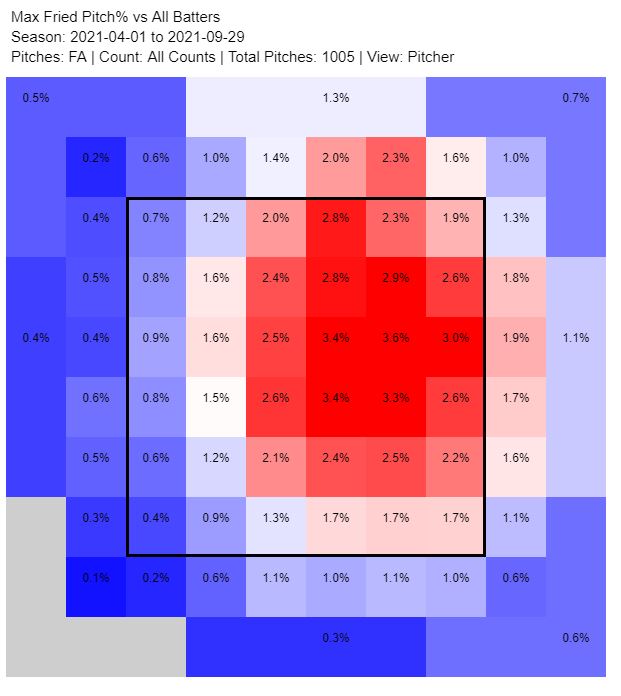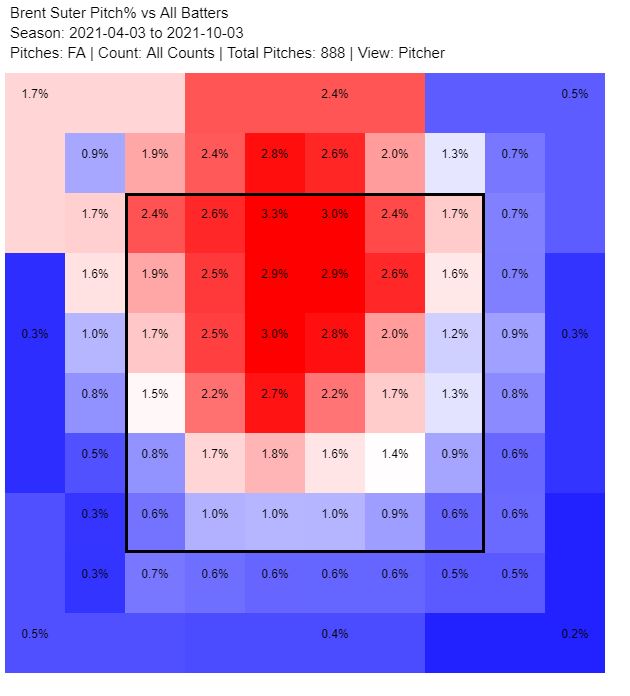Brent Suter, the Slowest Unicorn
Brent Suter shouldn’t be this good. Honestly, he shouldn’t even be good, period. He throws a fastball in the mid-80s, and he throws it a lot. He complements it with a changeup and a curveball, but neither of those pitches are excellent. No, it’s mostly a slow fastball; among pitchers who threw at least 50 innings last year, Suter had the fourth-highest fastball frequency (77.1%). If you’re Richard Rodríguez (No. 2 on the list) or Jake McGee (No. 1), sure, fire away. But Brent Suter? It feels like a recipe for failure — and yet, it keeps working for him.
Why? I decided to investigate it, because frankly, I like oddities. Do you really need to read about how Max Scherzer succeeds by throwing multiple excellent pitches with pinpoint control? Probably not; he’s just great. But Suter throws BP fastballs and embarrasses hitters. Look at this:
That’s crazy — I didn’t know Jace Peterson could play first base!
Okay, sorry about the Milwaukee first base situation dig. It’s the last one this article, I promise. More importantly, that was 85 down the pipe, and Pete Alonso, a man known for his ability to hit batting practice fastballs very far, popped it up. It’s no fluke, either. Suter allowed a .369 wOBA when opponents put his fastball into play in 2021, better than other pitchers with flashier heaters: Sandy Alcantara (.370), Robbie Ray (.373), Blake Snell (.374), and Lucas Giolito (.380), just to name a few.
How do you keep opposing hitters from doing damage? The simplest way is to make them hit the ball one of two places: into the ground or straight up. As it turns out, that’s basically what Suter does. Opponents hit grounders 49.1% of the time against his four-seamer, the 12th-highest mark in baseball. They hit either a grounder or pop-up 55% of the time, the ninth-best mark.
Four-seamers don’t usually generate a pile of grounders, as you’re no doubt aware. The pitcher who got grounders on the highest proportion of his four-seamers? Tyler Rogers, who pitches upside down. Second place? That would be Max Fried, and while Fried isn’t weird like Rogers is, he locates his fastball down in the zone (relative to where four-seamers normally live) on average:

Suter doesn’t do any of that. He throws from an over-the-top arm angle and locates the ball up in the zone. He’s in the top 15% of all pitchers when it comes to locating his four-seamer in the upper third of the strike zone or higher. In fact, his pitch location chart looks like a poster for the fly-balls-and-whiffs crowd:

When Suter leaves the ball high (2.75 feet off the ground or higher is the cutoff I used, which roughly corresponds with the upper third of the zone), he runs a 42.9% groundball rate. The league as a whole checks in at 28.6% on those fastballs. That’s a low number — league-average groundball rate hovers around 43% in most years — but it’s a low number with good reason. Four-seamers rise relative to spin-less flight, which means batters generally impact them from underneath. That’s also true of pitches high in the zone; it’s much easier to swing below the midline of a ball that’s high in the zone as compared to one at the knees. Combine the two, and high pitches get hit in the air quite frequently. And yet here’s Suter, throwing 85, and still somehow batters can’t figure him out and put the dang ball in the air.
I’ll level with you: I spent a while trying to think of why this might be the case and didn’t come up with any quick answers. What Suter is doing just defies how the pitch type should work, and it’s not like he throws a sinker that pitch systems incorrectly call a four-seamer; the pitch has a bit of cut, but it gets far more vertical movement than horizontal. But looking into past years of pitch data gave me an idea:
| Year | Velo | xMov (in) | vMov (in) | GB% | SwStr% | wOBACON |
|---|---|---|---|---|---|---|
| 2016 | 84.4 | -0.8 | 4.4 | 47.1% | 7.6% | .368 |
| 2017 | 86 | -0.6 | 6.2 | 44.7% | 8.5% | .328 |
| 2018 | 86.9 | 0.1 | 7.2 | 32.7% | 10.8% | .397 |
| 2019 | 87.6 | -1.2 | 5.8 | 54.1% | 15.0% | .192 |
| 2020 | 85.6 | -2.2 | 5.9 | 48.4% | 15.8% | .352 |
| 2021 | 87.3 | -2.1 | 5.7 | 48.8% | 9.7% | .369 |
In 2018, Suter threw a “perfect” four-seam fastball — no horizontal movement at all, just pure backspin. He didn’t have much success with it; it’s certainly not a bat-missing monster, and opposing hitters did a ton of damage when they made contact, to the tune of a .397 wOBA. He didn’t make up for it with any overpowering secondaries, and it was no surprise when the Brewers sent him to the bullpen after a two-year experiment with starting (he was a starter in the minors, but so is everyone these days).
When Suter came out of the bullpen next year, he did so with a new fastball shape. It was faster, yes, but he also added some cut to it, which gave it glove-side movement that’s rare in four-seam fastballs. How rare? Here’s a list of lefty pitchers who threw 100 four-seamers in 2021 and got glove-side break on it:
| Pitcher | xMov (in) |
|---|---|
| Brent Suter | -2.1 |
| Blake Taylor | -1.7 |
| Clayton Kershaw | -0.6 |
It’s really hard to do! It has to do with arm angle, I think; unless you’re right over the top, the bend of your arm combined with the four-seam topspin moves the ball arm-side. I often think back to Kevin Goldstein’s article about fastball shape, how batters crush fastballs with “standard” movement. Suter has always lived far from that axis — he was in the majors with a mid-80s fastball in the first place, so he was doing something right — but his new shape is even more extreme.
I’m not trying to say it’s an uncomfortable at-bat, because facing a fastball in the 80s just can’t be that scary for a batter, but it is confusing. The pitch doesn’t move the way you think it should, and wait shouldn’t it be tailing away instead of coming toward me, and oh no it’s time to swing. That’s not the way that four-seamers usually beat batters, but that doesn’t mean it doesn’t work.
In fact, you can make a good argument that Suter doesn’t even throw a four-seamer; he gets a ton of cut on the pitch. That’s another way of saying that he throws it with more gyroscopic spin, and less transverse spin, than what we’re used to. An idealized four-seamer is all transverse spin — all backspin, which pushes the ball upward against gravity. Suter, on the other hand, is nearly half gyro spin; he throws one of the least “spin-efficient” four-seamers in the game at 65% transverse efficiency.
Accidentally getting too much cut on your four-seamer can blunt its effectiveness, but that’s not what’s going on with Suter. He’s purposefully getting a lot of cut on the pitch, and it turns batters inside out. When your only real comparable pitch is Clayton Kershaw’s four-seamer (Blake Taylor is a less flattering comparison, so I’m using my writerly license and ignoring him), you’re definitely doing something right. And why does Suter get more grounders than Kershaw? Because his pitch runs in and down on righty batters relative to Kershaw’s, essentially jamming them.
Am I calling Suter basically Clayton Kershaw? I most emphatically am not — but I do think that his fastball is better. It’s one of the few fastballs in the game without a close analog, and while it’s fun and easy to call it a “batting practice fastball,” it’s definitely not. The strange action, the over-the-top release, the rise/run combination — it’s a look that hitters simply don’t get, and it shows in their results against a fastball that has below-average spin, below-average transverse spin, and below-average velocity.
If there’s a weakness to Suter’s game, I’d guess that it’s familiarity. Let a batter see enough of these, and they might start to work out the movement. When they do that, it’s not going to be a party; it is, to reiterate, a mid-80s fastball. Suter had sharp times-through-the-order splits as a starter, and while they happened in far too small of a sample size to be meaningful, it makes a ton of sense that he’d struggle against hitters as they got used to tracking the pitch. As I mentioned earlier, he doesn’t really have any other great pitches to throw off of it.
So is Suter relief-only? I think so. But that’s not a bad thing, because he’s been downright excellent in that role over the last three years, and he has the stamina to give the Brewers more than an inning of work when they need it. Nineteen of his 60 relief appearances in 2021 went longer than three outs, and he threw more innings than every other Milwaukee reliever. You might think of Josh Hader as the fireman there, but he’s a garden-variety closer at this point; Suter does the multi-inning job.
On a team with a less dominant back of the bullpen — Hader and Devin Williams are obviously great, and Brad Boxberger looks like a force with his newly-emphasized slider — Suter might even be a good pick for high-leverage work. But even with that beastly trio locking down tight games, he is key to Milwaukee’s approach. Brewers starters don’t face many batters a third time through the order, a modern pitching strategy that puts strain on the bullpen in exchange for better matchups. Suter handles a lot of that strain, and he does so with an ERA in the 3s.
The way he does it might not look pretty. Heck, the way he does it might not last; batters made far more contact against him in 2021 than they did in his previous two years of relief, which led to fewer strikeouts and more walks. But for now, it’s working. A 31st-round draft pick who throws his extremely slow fastball three-quarters of the time is the glue holding together one of the best pitching staffs in baseball.
Ben is a writer at FanGraphs. He can be found on Bluesky @benclemens.

I don’t know what kind of effect it has on batters, but I also think it’s worthy of note just how little time Suter spends holding onto the ball in between pitches. He gets the ball absolutely GOES.